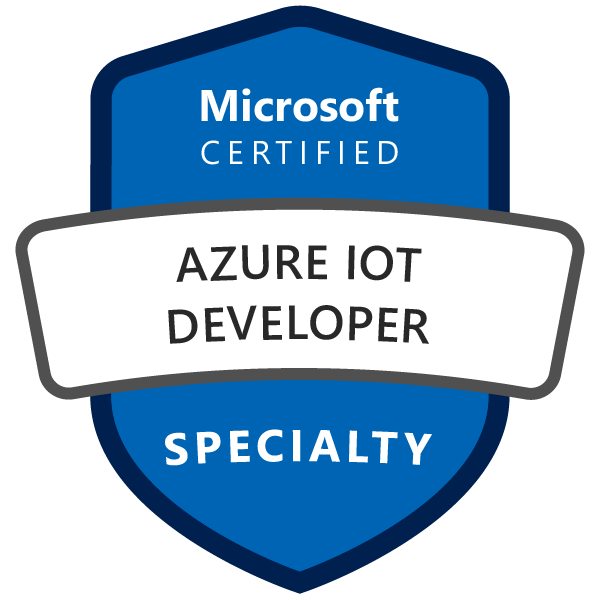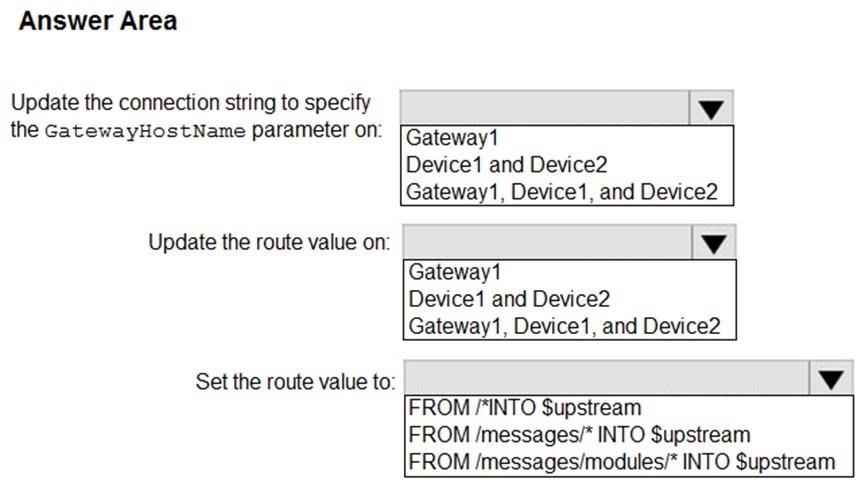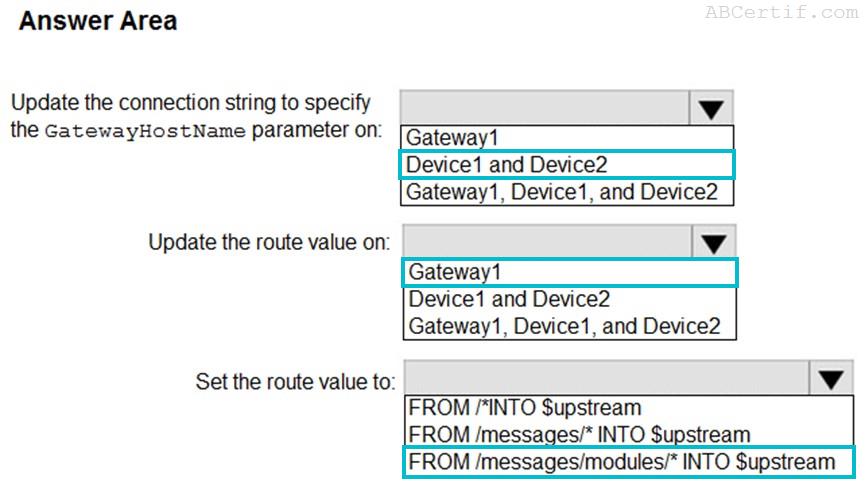
Microsoft (AZ-220) Exam Questions And Answers page 1
You have an Azure subscription that contains a resource group named RG1.
You need to deploy the Device Provisioning Service. The solution must ensure that the Device Provisioning Service can accept new device enrollments.
You create a Device Provisioning Service instance.
Which two actions should you perform next? Each correct answer presents part of the solution.
NOTE: Each correct selection is worth one point.
You need to deploy the Device Provisioning Service. The solution must ensure that the Device Provisioning Service can accept new device enrollments.
You create a Device Provisioning Service instance.
Which two actions should you perform next? Each correct answer presents part of the solution.
NOTE: Each correct selection is worth one point.
From the Azure portal, create a new Azure IoT hub.
From the Manage allocation policy blade of the Device Provisioning Service, configure an allocation policy.
From the Certificates blade of the Device Provisioning Service, upload an X.509 certificate to the Device Provisioning Service.
Device Provisioning and Management
Developing IoT Solutions
You have 100 devices that connect to an Azure IoT hub named Hub1. The devices connect by using a symmetric key.
You deploy an IoT hub named Hub2.
You need to migrate 10 devices from Hub1 to Hub2. The solution must ensure that the devices retain the existing symmetric key.
What should you do?
You deploy an IoT hub named Hub2.
You need to migrate 10 devices from Hub1 to Hub2. The solution must ensure that the devices retain the existing symmetric key.
What should you do?
Add a desired property to the device twin of Hub2. Update the endpoint of the 10 devices to use Hub2.
Add a desired property to the device twin of Hub1. Recreate the device identity on Hub2.
Recreate the device identity on Hub2. Update the endpoint of the 10 devices to use Hub2.
Disable the 10 devices on Hub1. Update the endpoint of the 10 devices to use Hub2.
Device Provisioning and Management
IoT Security and Compliance
You have an Azure IoT solution.
You need to test that the solution remains functional if IoT Hub is affected by a regional outage.
What should you do?
You need to test that the solution remains functional if IoT Hub is affected by a regional outage.
What should you do?
From the IoT hub, set Allow public network access to Disabled.
From the IoT hub, start a manual failover.
From the Device Provisioning Service (DPS), unlink the IoT hub.
From the IoT hub, select Disable fallback route.
Introduction to Azure IoT
IoT Security and Compliance
You have an Azure IoT hub.
You need to enable Azure Defender for IoT on the IoT hub.
What should you do?
You need to enable Azure Defender for IoT on the IoT hub.
What should you do?
From the Security settings of the IoT hub, select Secure your IoT solution.
From the Diagnostics settings of the IoT hub, select Add diagnostic setting.
From Defender, add a security policy.
From Defender, configure security alerts.
IoT Security and Compliance
Developing IoT Solutions
Note: This question is part of a series of questions that present the same scenario. Each question in the series contains a unique solution that might meet the stated goals. Some question sets might have more than one correct solution, while others might not have a correct solution.
After you answer a question in this section, you will NOT be able to return to it. As a result, these questions will not appear in the review screen.
You have devices that connect to an Azure IoT hub. Each device has a fixed GPS location that includes latitude and longitude.
You discover that a device entry in the identity registry of the IoT hub is missing the GPS location.
You need to configure the GPS location for the device entry. The solution must prevent the changes from being propagated to the physical device.
Solution: You use an Azure policy to apply tags to a resource group.
Does the solution meet the goal?
After you answer a question in this section, you will NOT be able to return to it. As a result, these questions will not appear in the review screen.
You have devices that connect to an Azure IoT hub. Each device has a fixed GPS location that includes latitude and longitude.
You discover that a device entry in the identity registry of the IoT hub is missing the GPS location.
You need to configure the GPS location for the device entry. The solution must prevent the changes from being propagated to the physical device.
Solution: You use an Azure policy to apply tags to a resource group.
Does the solution meet the goal?
Yes
No
Device Provisioning and Management
IoT Security and Compliance
You have 1,000 devices that connect to a standard tier Azure IoT hub.
All the devices are commissioned and send telemetry events to the built-in IoT Hub endpoint.
You configure message enrichment on the events endpoint and set the enrichment value to $twin.tags.ipV4.
When you inspect messages on the events endpoint, you discover that all the messages are stamped with a string of "$twin.tags.ipV4".
What are two possible causes of the issue? Each correct answer presents a complete solution.
NOTE: Each correct selection is worth one point.
All the devices are commissioned and send telemetry events to the built-in IoT Hub endpoint.
You configure message enrichment on the events endpoint and set the enrichment value to $twin.tags.ipV4.
When you inspect messages on the events endpoint, you discover that all the messages are stamped with a string of "$twin.tags.ipV4".
What are two possible causes of the issue? Each correct answer presents a complete solution.
NOTE: Each correct selection is worth one point.
The ipV4 tag is a restricted twin property that is unavailable for message enrichment.
A standard tier IoT hub does not support device twin properties in message enrichments.
The device sending the message has no device twin.
Message enrichment cannot be added to messages going to a built-in endpoint.
The device twin path used for the value of the enrichment does not exist.
The device twin property value used for message enrichment is set to "$twin.tags.ipV4".
Data Ingestion and Processing
IoT Security and Compliance
Note: This question is part of a series of questions that present the same scenario. Each question in the series contains a unique solution that might meet the stated goals. Some question sets might have more than one correct solution, while others might not have a correct solution.
After you answer a question in this section, you will NOT be able to return to it. As a result, these questions will not appear in the review screen.
You have an Azure IoT solution that includes an Azure IoT hub and an Azure IoT Edge device.
You plan to deploy 10 Bluetooth sensors. The sensors do not support MQTT, AMQP, or HTTPS.
You need to ensure that all the sensors appear in the IoT hub as a single device.
Solution: You configure the IoT Edge device as an IoT Edge identity translation gateway. You configure the sensors to connect to the device.
Does this meet the goal?
After you answer a question in this section, you will NOT be able to return to it. As a result, these questions will not appear in the review screen.
You have an Azure IoT solution that includes an Azure IoT hub and an Azure IoT Edge device.
You plan to deploy 10 Bluetooth sensors. The sensors do not support MQTT, AMQP, or HTTPS.
You need to ensure that all the sensors appear in the IoT hub as a single device.
Solution: You configure the IoT Edge device as an IoT Edge identity translation gateway. You configure the sensors to connect to the device.
Does this meet the goal?
Yes
No
Device Provisioning and Management
IoT Security and Compliance
You have an Azure subscription that contains an Azure IoT hub and two IoT devices named Device1 and Device2.
You plan to deploy an Azure IoT Edge gateway device named Gateway1.
You need to ensure that all device-to-cloud messages and twin change notifications from Device1 and Device2 to the IoT hub are routed by using Gateway1.
What tasks should you perform to configure the devices? To answer, select the appropriate options in the answer area.
NOTE: Each correct selection is worth one point.
You plan to deploy an Azure IoT Edge gateway device named Gateway1.
You need to ensure that all device-to-cloud messages and twin change notifications from Device1 and Device2 to the IoT hub are routed by using Gateway1.
What tasks should you perform to configure the devices? To answer, select the appropriate options in the answer area.
NOTE: Each correct selection is worth one point.


Introduction to Azure IoT
Data Ingestion and Processing
You plan to deploy Azure Time Series Insights.
What should you create on iothub1 before you deploy Time Series Insights?
What should you create on iothub1 before you deploy Time Series Insights?
a new message route
a new consumer group
a new shared access policy
an IP filter rule
Introduction to Azure IoT
Data Ingestion and Processing
You have an Azure subscription that contains an Azure Time Series Insights environment. The environment has the properties shown in the following table.

You need to create a time series query.
Which two time series expressions can be correctly used as part of the query? Each correct answer presents a complete solution.
NOTE: Each correct selection is worth one point.

You need to create a time series query.
Which two time series expressions can be correctly used as part of the query? Each correct answer presents a complete solution.
NOTE: Each correct selection is worth one point.
$event.p2 = 'abc'
$event.p4.p5 = 0.0
$event['p1'] != NULL
$event.p1.String = 'abc'
Data Ingestion and Processing
IoT Security and Compliance

Comments